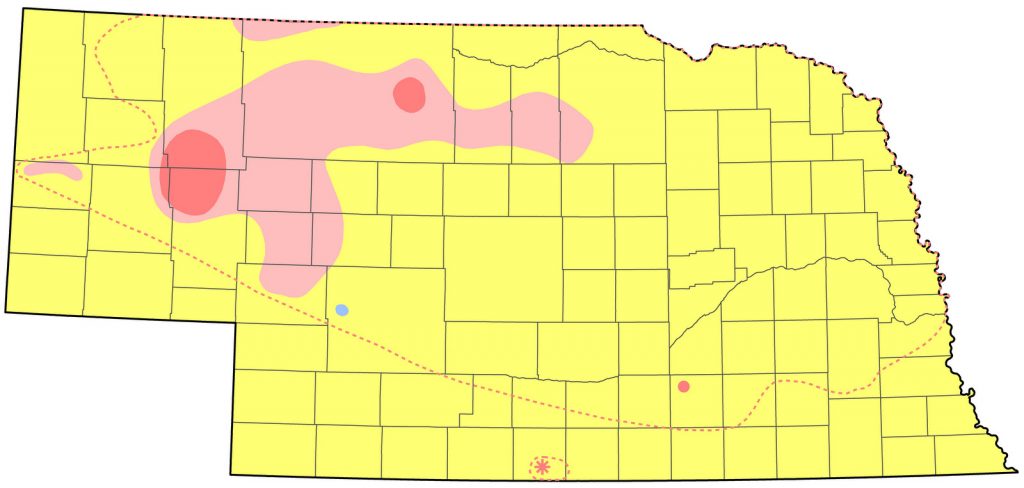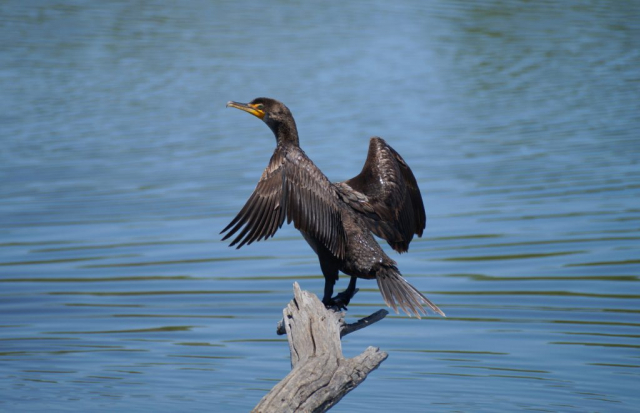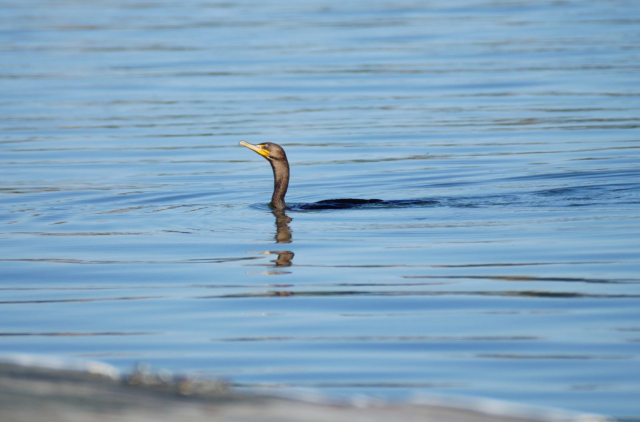Nannopterum auritum auritum
Status: Abundant regular spring and fall migrant statewide. Locally common regular breeder north and west, rare casual elsewhere. Locally uncommon regular summer visitor away from breeding range locations. Rare casual winter visitor south.

Documentation: Specimen: UNSM ZM7651, 1 Nov 1932 North Platte, Lincoln Co.
Taxonomy: Chesser et al (2021) split New World Double-crested, Neotropic, and Flightless cormorants from Phalacrocorax and resurrected genus Nannopterum for them, which required a specific epithet change from auritus to auritum.
Five subspecies are recognized (AviList 2025), auritum of the North American Interior and east to the northern Atlantic coast, floridanum of the southern Atlantic coast, Florida, Bahamas, and Cuba, albociliatum of the Pacific Coast from British Columbia to the Gulf of Mexico, cincinatum of the Aleutian Islands and southern Alaska, and heuretum of Cuba and the Bahamas.
Nebraska birds are presumed auritum.
A Nebraska hybrid with Neotropic Cormorant is discussed in the Double-crested x Neotropic Cormorant (hybrid) species account.
Spring: Feb 27, 28, 28 <<<>>> summer
Earlier dates are 12-17 2013 Lincoln Co, 14 Feb 2017 (9) Lancaster Co, 15-29 Feb 2020 Hall Co, 17 Feb 2017 (35) Richardson Co, 18 Feb 2017 Lincoln Co, 20 Feb 1991 Douglas-Sarpy Cos, 22 Feb 2017 Lancaster Co, and 23 Feb 1958 Lincoln Co.
Movement normally commences in late Mar and peaks in early to mid-Apr, but there are several late spring reports into summer of non-breeding immatures.
- High counts: 6000 at Branched Oak Lake, Lancaster Co 15 Apr 2017, 5000 near Odessa, Buffalo Co 4 Apr 2004, and 5000 in Lancaster Co 13 Apr 2007.
Summer: Around 1900 breeding was unknown (Bruner et al 1904), but by the 1950s Rapp et al (1958) listed Scotts Bluff, Garden, Keith, Cherry, Grant, and Lincoln as counties where breeding had occurred. Ducey (1988) presented no breeding records prior to 1921 but added Sheridan Co to the list of Rapp et al (1958).
Breeding occurs regularly at Crescent Lake NWR, Garden Co and Valentine NWR, Cherry Co. The highest tally of nests at Valentine NWR is 922, on 7 Jul 1988 (McDaniel; Mollhoff 2022). A total of 43 nests were located at Crescent Lake NWR 15 May 2006, and 40+ were occupying nests at Pony Lake, Valentine NWR 26 May 2007. Nesting occurred in 2006 at Cottonwood-Stevenson WMA, Grant Co. In 2021 about 250 nests were located on an island in Wolf Lake, Garden Co, associated with 1200 American White Pelican nests; the colony was photographed 6 Aug (John Sidle, personal communication). Also in 2021, 75-100 nests were at Island Lake, Crescent Lake NWR, also in association with American White Pelicans (Marlin French, personal communication).
Elsewhere, breeding is sporadic, as breeding habitat of trees in standing water tends to be ephemeral.
Nesting occurs in the Lake McConaughy area, Keith Co, but on a much smaller scale and only sporadically compared to when Kingsley Dam was under construction; the flooded dead trees attracted a peak of 228 nests and 1000 birds in the 1940s (Collister 1948, Rosche 1994). The first nest here since the 1940s was just below Kingsley Dam 28 Apr 2007; two nests and 200-250 cormorants were there 10 Jun. Although 97 cormorants were at Lake Ogallala 7 Jun and “hundreds” were there 18 Jun 2008, and in 2009 an estimated 100 cormorants were there, no nests were found either year. This colony appeared to be abandoned in 2017.
In Scotts Bluff Co, breeding occurred at Lake Alice, North Platte NWR a few years prior to 2015, and “2-3 giant cottonwoods were full of nests” along the North Platte River just downstream of the Morrill bridge 20 May 2011 (Andrew Pierson, personal communication).
There are several nesting reports in the eastern Sandhills. Breeding occurred in 1988 in Rock Co, where 29 nests were counted (Bennett 1989) and in 1997 nesting was noted at Lake George (eight nests), and Twin Lakes (two nests), both sites in Rock Co. Nesting probably occurred at Swan Lake, Holt Co, in 1988 (Blake and Ducey 1991).
Nesting has occurred sporadically at the west end of Harlan County Reservoir, where nine nests were noted in 1995, at least 26 nests in 1996, and as many as 73 birds were on nests in 2001. Low water in 2002 and 2003 precluded nesting there, however, and by 2005 most of the nest trees had been blown down. Again in 2009, around 75 birds were present, with 25+ nests 29 Apr in live trees. In 2010 none were present until 32 appeared 11 Jul, and in 2011, as many as 55 birds were at the lake, but no nesting was observed.
The first Rainwater Basin nesting record involved two pairs building nests in small willows at Harvard WPA, Clay Co 19 Jul 2015, and incubating by 26 Jul, when two additional nests were being built (Jorgensen 2015). The four nests were abandoned by 26 Aug, possibly due to the ending of a temporary irruption in the local frog (Pseudacris spp.) population.
Non-breeders, mostly immatures, are common throughout the north and west in mid-summer but are uncommon and local in the south and east, with fewest reports mid-Jun through mid-Jul. Reports of summering non-breeders during this period are annual at favored locations such as Branched Oak Lake, Lancaster Co, where high counts are 30 on 6 Jul 2023 and 23 on 23 Jun 2017.
See Comments (below).
- Breeding Phenology:
Eggs: 9 Apr- 9 Jul (Mollhoff 2022)
Nestlings: 5 Jun-4 Jul
Fall: summer <<<>>> Jan 6, 8, 8
Later dates away from Sutherland Reservoir, Lincoln Co, are 16 Jan 2025 (4) Gibbon, Buffalo Co, and one at Gavins’s Point Dam, Cedar Co 22 Jan 2023.
Peak numbers pass through in Oct, and high counts occur at favored staging areas such as Calamus Reservoir, Loup Co, where 7500 were present 15 Oct 2012 (Dinan and Jorgensen 2014).
- High counts: 12,000 at Harlan County Reservoir 5 Oct 2008, 10,000 there 14 Oct 2011, and 7500 at Calamus Reservoir 15 Oct 2012 (Jorgensen and Dinan 2014).
Winter: Cormorants typically are not present during winter. However, at Sutherland Reservoir, Lincoln Co, a cooling pond remains open in winter due to water releases from a coal-fired power station. Overwintering was first noted there in 1995-96, but the four birds there 22 Dec dwindled to one by 13 Jan. Since then, overwintering has occurred most years; best winter count is the 24 there 29 Dec 2018, although only four were still there 10 Feb 2019. A maximum of 20 were wintering there 2014-2015 along with up to 24 American White Pelicans and even Nebraska’s first wintering Brown Pelican. In winter 2022-2023, peak tally at this location was 64 on 9 Dec, declining to four on 11 Feb. In 2023-2024 numbers were record high; peak count was 151 on 22 Dec, 100 were still present 12 Jan, declining to 32 on 15 Feb. Peak in 2024-2025 was 83 on 16 Jan.
Elsewhere, reports of overwintering are few. At least one wintered and 9-15 were present 14- 15 Feb at Harlan County Reservoir 1999-2000, another was there 22 Jan 2012, and an injured bird survived at Lake McConaughy at least until 29 Jan 2000. An immature wintered at Hiatt Memorial Wetlands, North Platte, Lincoln Co 2012-2013. A group of 10-14 may have wintered at Branched Oak Lake, Lancaster Co 2015-2016; although 14 were there 12 Jan, none were reported subsequently.
Additional midwinter reports (Jan 9-Feb 12) are 12 Jan 1992 Lancaster Co, 16 Jan 1999 Harlan County Reservoir, 29 Jan 2000 Cunningham Lake, Douglas Co, 30 Jan 1972 at Lake McConaughy (Rosche 1994), 2 Feb 2025 Gavin’s Point Dam, Cedar Co, 9 Feb 2003 Johnson Lake, Gosper Co, 9 Feb 2017 (3) Deuel Co, and 9 Feb 2024 (6) Swanson Reservoir, Hitchcock Co.
Comments: Double-crested Cormorant numbers have increased throughout their range in recent decades. Consequently, conflicts between sport fish angling interests and American White Pelicans and Double-crested Cormorants have increased in number and intensity. In parts of the United States, Double-crested Cormorant numbers are lethally controlled to reduce impacts to property or sport fish resources through federal depredation orders (50 CFR 21.48). Concerns over impacts to sport fish resources have also been raised in Nebraska. This issue was explored by Dinan and Jorgensen (2014), who provided baseline count data on these species in the Sandhills in fall 2012 and concluded Double-crested Cormorants are unlikely to be negatively affecting sport fish resources in the state.
Images
Abbreviations
NWR: National Wildlife Refuge
UNSM: University of Nebraska State Museum
WMA: Wildlife Management Area (State)
WPA: Waterfowl Production Area (Federal)
Literature Cited</strong
AviList Core Team, 2025. AviList: The Global Avian Checklist, v2025. https://doi.org/10.2173/avilist.v2025.
Bennett, E.V. 1989. 1988 Nebraska nesting report. NBR 57: 34-41.
Blake, L., and J. E. Ducey. 1991. Birds of the eastern Sandhills in Holt County, Nebraska. NBR 59: 103-132.
Bruner, L., R.H. Wolcott, and M.H. Swenk. 1904. A preliminary review of the birds of Nebraska, with synopses. Klopp and Bartlett, Omaha, Nebraska, USA.
Chesser, R.T., S.M. Billerman, K. Burns, C. Cicero, J.L. Dunn, B.E. Hernández-Baños, A.W. Kratter, I.J. Lovette, N.A. Mason, P.C. Rasmussen, J.V. Remsen, Jr., D.F. Stotz, and K. Winker. 2021. Sixty-second Supplement to the American Ornithological Society’s Check-list of North American Birds. Ornithology 138, Issue 3 https://doi.org/10.1093/ornithology/ukab037.
Collister, A. 1948. Nesting of the Double-crested Cormorant in Nebraska. NBR 16: 22-26.
Dinan, L.R., and J.G. Jorgensen. 2014. Double-crested Cormorant and American White Pelican abundance at Sandhills lakes during fall migration. NBR 82: 73-80.
Ducey, J.E. 1988. Nebraska birds, breeding status and distribution. Simmons-Boardman Books, Omaha, Nebraska, USA.
Gill, F., D. Donsker, and P. Rasmussen (Eds). 2021. IOC World Bird List (v 11.2). Doi 10.14344/IOC.ML.11.2. http://www.worldbirdnames.org/.
Jorgensen, J.G. 2015. Cormorants nesting in Rainwater Basin. Nongame Bird blog post, accessed 30 April 2018.
Mollhoff, W.J. 2022. Nest records of Nebraska birds. Nebraska Ornithologists’ Union Occasional Paper Number 9.
Rapp, W.F. Jr., J.L.C. Rapp, H.E. Baumgarten, and R.A. Moser. 1958. Revised checklist of Nebraska birds. Occasional Papers 5, Nebraska Ornithologists’ Union, Crete, Nebraska, USA.
Rosche, R.C. 1994. Birds of the Lake McConaughy area and the North Platte River valley, Nebraska. Published by the author, Chadron, Nebraska, USA.
Recommended Citation
Silcock, W.R., and J.G. Jorgensen. 2025. Double-crested Cormorant (Nannopterum auritum auritum). In Birds of Nebraska — Online. www.BirdsofNebraska.org
Birds of Nebraska – Online
Updated 31 Jul 2025


